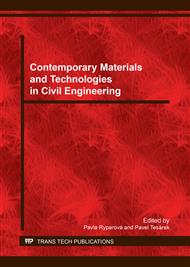p.23
p.29
p.37
p.43
p.49
p.55
p.60
p.66
p.74
The Influence of Rainfall Humidity on the Moisture Regime of Envelope Structures with Internal Insulation
Abstract:
While the matters of the moisture of external walls of historical buildings it turned out that apart from classical sources of moisture (such as capillary attraction, condensation etc.) there is another source which is often left behind – rainfall humidity which leaks to perimeter walls from the exterior. Whilst the Czech approach of standard assessment works with condensed moisture only, some foreign authors (especially those from Germany) point out a notable influence of rainfall humidity on the moisture regime of the mentioned constructions. Its amount exceeds the amount of rainfall that leaks into the construction due to diffusion by several times. The issue deserves to be examined in more detail, but the use of nanotechnology could help to solve or improve the problem. In some cases it would be possible to apply the suspension with added nanoparticles into the insulated masonry and improve the properties of masonry, which is facing to rainwater
Info:
Periodical:
Pages:
49-54
Citation:
Online since:
March 2017
Authors:
Price:
Сopyright:
© 2017 Trans Tech Publications Ltd. All Rights Reserved
Share:
Citation:


